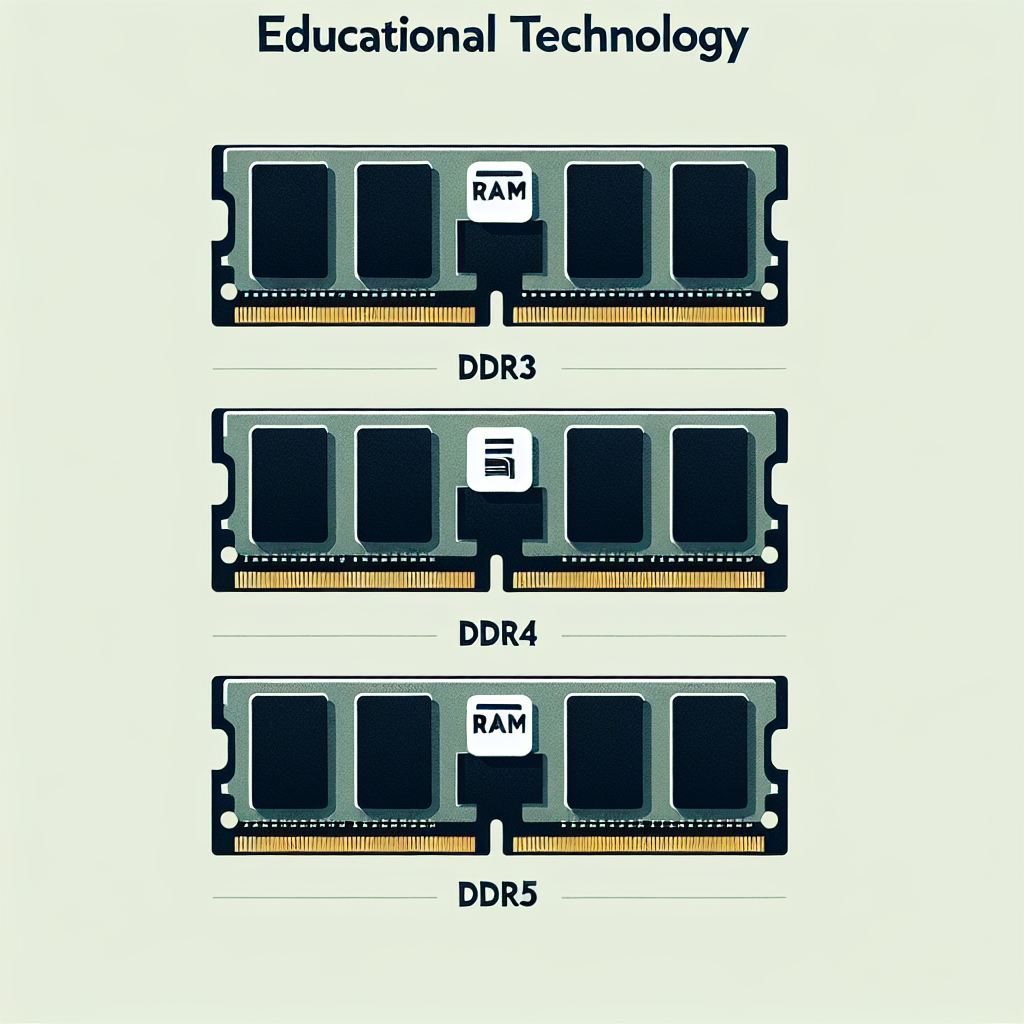Random Access Memory, commonly known as RAM, is a critical component in our computing devices. As technology evolves, so does the architecture and efficiency of RAM. This article will explore the key differences between DDR3, DDR4, and DDR5 RAM. We will examine their speed, power consumption, and other notable features. Let’s dive into it!
Overview and Evolution of DDR RAM
DDR, or Double Data Rate, refers to a type of memory technology that allows for double the data transfer rates compared to single data rate memory. Below is a quick comparison of the three major types of DDR RAM:
| Feature | DDR3 | DDR4 | DDR5 |
|---|---|---|---|
| Data Transfer Rate | 800 – 2133 MT/s | 1600 – 3200 MT/s | 4800 – 8400 MT/s |
| Voltage | 1.5V | 1.2V | 1.1V |
| Release Year | 2007 | 2014 | 2020 |
DDR3 RAM: The Workhorse
DDR3, introduced in 2007, was a significant improvement over its predecessor, DDR2. Offering data transfer rates of 800 to 2133 MT/s (Million Transfers per Second) and requiring a voltage of 1.5V, DDR3 quickly became the standard in personal computers, offering faster performance and greater efficiency. Though largely replaced by DDR4, it is still found in many older systems and applications.
DDR4 RAM: Speed and Efficiency
Introduced in 2014, DDR4 offered significant enhancements over DDR3. With data transfer rates ranging from 1600 to 3200 MT/s and operating at just 1.2V, DDR4 brought substantial speed improvements and lower power consumption. Additionally, DDR4 RAM boasts higher module densities, allowing for larger overall memory. These advancements made DDR4 the go-to choice for new builds and high-performance systems.
DDR5 RAM: The Future
Released in 2020, DDR5 represents the latest leap in RAM technology. This new standard is designed to meet the demands of modern computing, offering data transfer rates from 4800 to 8400 MT/s and running at an even lower voltage of 1.1V. DDR5 brings improved efficiency, higher bandwidth, and better performance. One of the notable features of DDR5 is its increased capacity per module, enabling machines to handle more memory-intensive applications seamlessly.
Key Differences Between DDR3, DDR4, and DDR5 RAM
Data Transfer Rate
The most obvious difference is the data transfer rate. DDR3 ranges from 800 to 2133 MT/s, DDR4 ranges from 1600 to 3200 MT/s, and DDR5 ranges from 4800 to 8400 MT/s. The faster the data transfer rate, the quicker your system can handle tasks.
Voltage
Each generation of RAM has reduced its voltage requirements. DDR3 uses 1.5V, DDR4 uses 1.2V, and DDR5 lowers this further to 1.1V. Reduced voltage translates to less power consumption and, consequently, better energy efficiency, which is crucial for both desktop and mobile devices.
Latency
Latency measures the delay before a transfer of data begins following an instruction. DDR4 and DDR5 have higher latency compared to DDR3. However, the increased speed and efficiency in DDR4 and DDR5 outweigh the higher latency, leading to overall better performance.
Capacity
New generations of DDR RAM support higher capacity modules. DDR3 typically maxes out at 8GB per module, DDR4 supports up to 16GB, and DDR5 can support even higher capacities, with future modules expected to offer up to 64GB per module. This allows for greater overall system memory, beneficial for modern applications and multitasking environments.
Practical Applications and Use Cases
Gaming
Gamers generally seek the best possible performance, making DDR4 and DDR5 ideal choices due to their higher speed and efficiency. While DDR4 is sufficient for most games today, DDR5 is becoming increasingly popular as games demand more resources.
Content Creation
Content creators working with video editing, 3D rendering, and other intensive tasks will benefit from the higher capacities and faster speeds of DDR4 and DDR5. The increased bandwidth and lower power consumption make these RAM types better suited for handling large files and multitasking.
Everyday Computing
For daily activities such as browsing the internet, office applications, and media consumption, DDR3 RAM is often sufficient. However, as software becomes more demanding, upgrading to DDR4 or DDR5 can future-proof your system and ensure smoother performance.
Enterprise and Servers
Data centers and enterprise-level applications require high efficiency, reliability, and large memory capacities. DDR5’s increased bandwidth and capacity make it the ideal choice for servers and other industrial applications where performance and power efficiency are critical.
Compatibility and Upgradability
It is crucial to note that DDR3, DDR4, and DDR5 RAM are not interchangeable. Each has a different pin configuration and voltage requirement, meaning you cannot simply swap out one for another on most motherboards. Ensure that your motherboard supports the specific type of DDR RAM you intend to use.
Conclusion
The evolution from DDR3 to DDR4 and now DDR5 RAM marks significant improvements in speed, efficiency, and capacity. While DDR3 remains functional for many tasks, DDR4 and DDR5 offer substantial advantages for modern applications. Whether you are upgrading an existing system or building a new one, understanding these differences will help you make an informed decision that meets your performance needs and future-proofs your investment.
